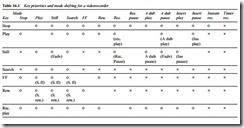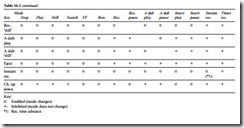SYSCON TROUBLESHOOTING
Microprocessors are inherently very reliable devices, as are their attendant expansion, bus-buffer and slave chips. Their internal workings are neither obvious nor important from the point of view of servicing work. The physical problems involved in removing and replacing a 80- or 160-pin chip are considerable, especially where
double-sided PC boards and miniature high-density construction methods are used. Before condemning any syscon-associated chip it is important to establish that the peripheral devices are correctly coupled and fault-free.
Mechanical and physical problems are most often at the root of what may appear to be an obscure system-control fault. Mechani- cally operated switches are perhaps the most unreliable devices in the ensemble, and typically cause wrong indications in the feedback system: a machine which refuses to accept a cassette but whose motors are running will probably have a faulty unload-end (mode) switch; one which makes no response to its deck-function keyboard should be checked for a faulty cassette-down switch or cassette- lamp; one which unloads within seconds of loading completion may well have a load-end (mode) switch problem or a slipping loading belt. Wherever wear- and corrosion-prone links in the chain are suspect, they should be checked first – belts, switches, relays and solenoids are high on the list. Optocouplers and to a lesser extent Hall-effect rotation sensors are suspect where a persistent ‘shutdown’ situation arises; oscilloscope and meter checks of deck sensors’ outputs should quickly ascertain the cause. Do not forget the head- rotation sensor, based on its PG pulse generator.
Much can be eliminated by a close study of the symptoms and a knowledge of the syscon’s ground rules. A machine which continu- ally goes into auto-rewind may have some leakage problem in its tape- end sensor; a situation where control keys operate wrong functions via an A-D converter circuit should lead to a check of the keys and keyboard for electrical leakage and then the A-D converter circuit and ladder resistor; one group of keys inoperative in a key-scanned machine suggests the loss of one strobe pulse; a refusal to accept a ‘record’ command can often be quickly traced to a faulty recorder- tab detector switch or the failure of its ‘OK’ message to reach the syscon centre; and so on. In all situations suspect the ICs last, and make the diagnostic process one of checking that all control and feedback information is correctly arriving at the input ports of the micro, and that all commands from its output ports are getting to their destinations, and there being correctly acted upon.
Complete lack of action and response in the micro will usually be due to failure of its operating voltage or cessation of the clock oscil- lator – which generally depends on an external ceramic filter or RC network tuned to around 400–600 kHz. Random functions at switch- on, ‘disobedience’ or no response may be due to a lack of reset pulse. Occasionally, interference spikes on the mains supply (or static charges around a portable) can ‘unhinge’ a micro, leading to random and bizarre functions; de-powering for a period to invoke a reset pulse usually clears the trouble. A similarly obscure set of symptoms can arise from one line in a data-, address- or control-bus becoming ‘stuck’ high or low – physical faults as well as faulty chips can cause this, and an oscilloscope and multimeter can be used to trace it. A logic probe is useful here; a logic analyser (see Chapter 22) is only required when it is necessary to check the timing and nature of the data on the bus, and that is quite rare.

